#Historia regum Britanniae
Text

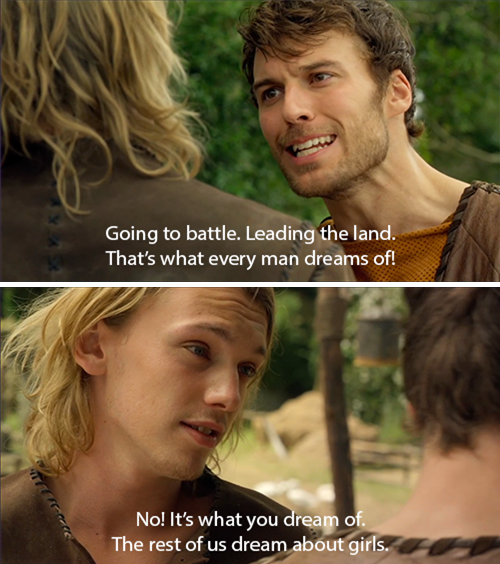



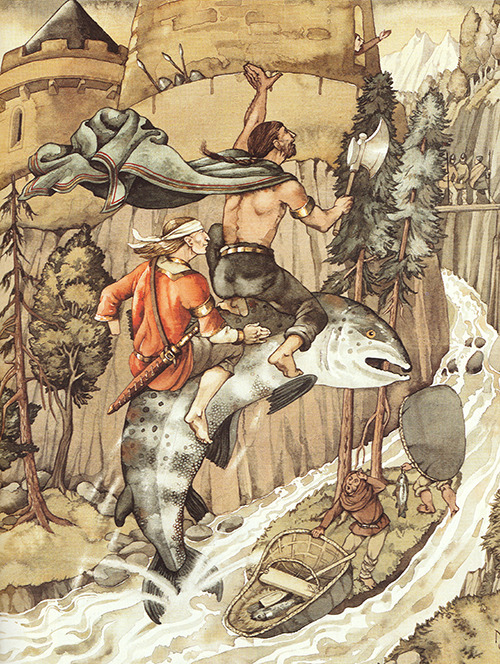

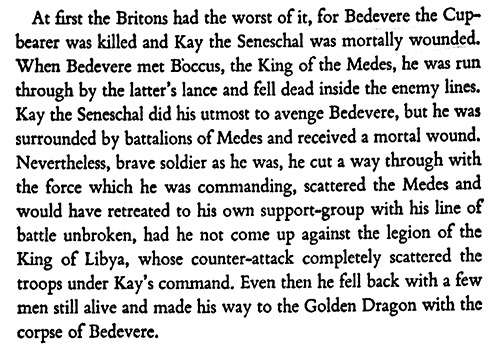

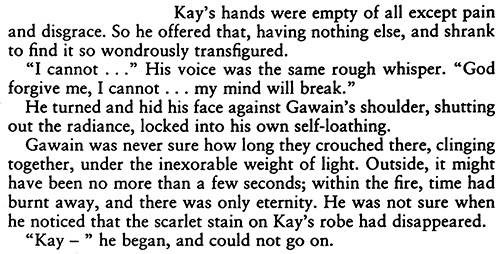




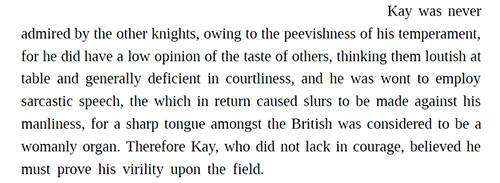
Exiled From Camelot, Cherith Baldry | Starz Camelot S1E1 | The Arthurian Companion, Phyllis Ann Karr | Morgawse, Lavinia Collins | The Mabinogion | The Quest for Olwen, Gwyn Thomas, Kevin Crossley-Holland, Margaret Jones | Guinevere, Lavinia Collins | Historia regum Britanniae, Geoffrey of Monmouth | Starz Camelot S1E3 | The Trial of Sir Kay, Cherith Baldry | Diu Crône | Morgan, Lavinia Collins | Hunt of The Hart Royal, Cherith Baldry | Camelot's Blood, Sarah Zettel | Arthur Rex, Thomas Berger
#arthurian legend#arthuriana#sir kay#kay#starz camelot#the mabinogion#historia regum britanniae#webweaving#web weaving#quotes#kay is...and he cannot stress this enough...NOT thinking about women#my post
365 notes
·
View notes
Text

I think its genuinely ironic how this statement from Malory quite aptly describes Geoffrey's Arthur...


#thomas malory#geoffrey of monmouth#le morte d'arthur#historia regum britanniae#arthuriana#arthurian legend#arthurian legends#arthurian mythology#king arthur
11 notes
·
View notes
Text
4. Brutus sends a letter to Pandrasus.
So as their chosen leader Brutus summoned the Trojans and fortified Assaracus’s towns. He took over the woods and hills, along with Assaracus and the multitude of men and women who continued to join them.
Then Brutus directed a letter to the king, in these words:
“To Pandrasus king of the Greeks, from Brutus leader of the survivors of Troy, greetings. It was a shame that a people arisen from the famed kin of Dardanus should be treated otherwise in your kingdom than your nobles’ peace of mind required; we have withdrawn, therefore, to the secret places of the woods.* For we would rather live like wild beasts, sustaining ourselves on game and forest plants in freedom, than be cheered any longer by common comforts while beneath the yoke of your servitude. If this offends your royal honour, we should not be blamed but pardoned, since it is the fault of every captive to wish to return to his former state. May you be moved with pity toward this people, therefore, to return the freedom which you stole from them, and permit them to dwell freely in the forest glades they have now occupied in order to flee their servitude. If not, then at least allow them safe passage to join the peoples of other lands.”
This passage was interesting because the letter was written in quite a different style from everything up to now. I wonder if it was drawn from or patterned on some other work? Anyway sarcasm is hard enough in English so the asterisked sentence especially had me tearing out my hair, I just finally cracked it today. (My husband couldn't get it and neither could my brother-in-law so I don't think it was just me being dumb?)
I used the first person plural to describe the Trojans in the letter for clarity. Geoffrey/Brutus has it in the third person singular with gens as the subject.
#arthuriana#history of the kings of britain#historia regum britanniae#geoffrey of monmouth#galfridus monumotensis#my translation#medieval literature#medieval latin#accusative with the infinitive my beloved#she is beautiful and I love her#she is also a pain in the butt at times
6 notes
·
View notes
Text
Development of Arthur - Geoffrey of Monmouth
1138 - Historia regum Britanniae and 1150 - Vita Merlini, by Geoffrey of Monmouth
Physical appearance
In battle, wore "a golden helmet with the carved likeness of a dragon upon the crest"
Carried the shield Pridwen, "which had the image of blessed Mary, Mother of God, painted upon it, keeping him always mindful of her"
Wielded Caliburn, "greatest of swords, which had been made in the isle of Avalon"
In his right hand during battle, carried the spear known as Ron, "long and broad and keen in warfare"
Personality
At 15 years old, described as "a youth of outstanding virtue and largesse. His innate goodness made him exhibit such grace that he was beloved by all the people". Possessed "both great courage and generosity".
"Such an outstanding man that no one could match him in virtue" according to Merlin
Takes counsel from advisors and vassals, listens to them, takes their advice into consideration.
Willing to engage in mercy if asked sufficiently, but more inclined to mercilessness as a default, and swift to punish treachery.
E.g.: let the surrendering Saxons go back to Germany, then hanged all the Saxon hostages when the Saxons turned back around and attacked the Briton countryside.
E.g.: had made the decision to let none of the Picts and Scots live, but the bishops and clergy of those lands approached him and begged for mercy, such that "pity finally moved him to tears".
Fierce fighter and battle-leader, even at a young age, often even rushing into the front lines to inspire and rally the troops and successfully killing… lots of men. (470, in one of his first campaigns.)
Loyal and protective of his vassals.
Rejoiced at being universally feared after his conquests, and desired to "submit all Europe to his rule", so he conquered Norway, Denmark, and Gaul (over the course of a 9-year campaign). Eventually also fought and defeated the forces of Rome (though didn't get to conquer all of Rome due to Mordred interrupting by taking over Britain).
Unhesitant to accept single combat, and would even seek out challenges (for example, fighting two different giants in single combat and winning). "For King Arthur possessed such strength and courage that he scoffed at bringing the entire army against such monsters. He wanted to impress his men by vanquishing the creature himself" and so would do stuff like get Bedivere and Kay to steal away with him so he can fight a giant in single combat
Eloquent and well-spoken, able to give speeches "bedecked with a truly Ciceronian eloquence".
Intelligent and well-educated.
Had a portentous dream (about a dragon and bear fighting), not very good at interpreting it though.
Reasonably devout Christian.
Family
Wife: Guinevere, "from a noble Roman family", who had been brought up in the household of Duke Cador of Cornwall and "surpassed all the other women of the isle in beauty."
Mother: Igerna, married to Gorlois the duke of Cornwall when Arthur was conceived. Her "beauty surpassed that of all the other women of Britain".
Father: Uther Pendragon, who was disguised as Gorlois when Arthur was conceived, then later married Igerna after Gorlois' death. Poisoned to death by the Saxons after defeating them. Buried in Stonehenge (the "Ring of Giants") next to his brother Aurelius.
Sister: Anna, "whose sons and grandsons will later rule the kingdom of Britain" per Merlin's prophecy. Married Loth of Lothian, lord of Leis, "a most experienced soldier, wise and mature".
Another sister? Possibly a half-sister from Igerna and Gorlois? Unclear and unnamed, but married Budicus the king of the Armorican Britons over in what's now part of France.
Nephew: Hoel, king of the Armorican Britons. Arthur and Hoel were very fond of one another, "united by love and a common blood", and Hoel was a strong ally. Arthur dropped everything to rally to his rescue when he was ill and besieged, and they showed affection to each other more than Arthur is described as doing with anyone else in Geoffrey's narrative. (I get the sense based on the timeline and interactions that they're of similar ages, but I don't have evidence of that.)
Nephew: Gawain, son of Loth of Lothian and Arthur's sister Anna.
Nephew: Mordred, son of Loth of Lothian and Arthur's sister Anna.
Brother-in-law: Loth of Lothian, Earl of Lothian and King of Norway
Paternal uncle: Constans, eldest brother of Uther, prior king of Britain before Vortigern and Vortimer, former monk, puppet of Vortigern, deceased before Arthur's birth.
Paternal uncle: Aurelius Ambrosius, older brother of Uther, prior king of Britain after Vortigern and before Uther, deceased before Arthur's birth.
Grandfather: Constantine, king of Britain before Constans, deceased before Arthur's birth
Grandmother: Unnamed woman from a noble family "who Guithelin had personally raised"
Timeline
Arthur's birth prophesied by Merlin to Uther, along with the birth of his sister Anna.
Conceived at Tintagel Castle in Cornwall when Uther lay with Igerna while disguised by Merlin as her husband Gorlois, who he was at war with at the time (because he wanted Igerna).
Uther and Igerna marry shortly thereafter, as Gorlois died in battle while Uther and Igerna were conceiving Arthur. They "lived together as equals bound by mutual affection".
Arthur's sister Anna is born to Uther and Igerna.
Uther becomes ill and places Loth of Lothian in charge of the armies to fight the invading Saxons. Uther is carried in a litter to command the battle when Loth is unable to command the Britons successfully, manages to mostly succeed until the Saxons assassinate him by poisoning a spring.
The leaders of the various provinces of Britain ask Archbishop Dubricius of Caerleon to crown 15-year-old Arthur as king.
Arthur "upheld the ancient custom" of gift-giving to soldiers who joined him until he ran began to run out of gifts, so then he attacked the Saxons to distribute their riches among his men.
Drove out the Saxons, then also the Picts, Scots, and Irish from Britain (the Britain of the time, which is now Wales and some of England).
Rebuilt the churches that the Saxons had destroyed.
Married Guinevere.
Subdued Ireland and Iceland, and then the kings of Gotland and Orkney surrendered to him before they could get invaded.
12 years of peace, during which Arthur invited "all the bravest men from the farflung reaches of his domain to join his household," and cultivated "such refinement in his court so that people far and wide sought to emulate it," and "every young nobleman was tempted to hang himself unless he could dress or bear arms like the knights of King Arthur's court".
Possibly around this time is when Arthur fights the giant Retho atop Mount Aravius, when Retho challenges him to single combat to add to Retho's kingly beard collection? (Retho was collecting beards of kings to make a fur coat.) Timeline is unclear here.
Conquers Norway and Denmark. Establishes Loth as king.
Spends 9 years conquering Gaul, holds court at Paris, gives Neudtria (Normandy) to Bedivere and gives the province of Anjou to Kay.
Big fancy feast/tournament/celebration at Caerlon, is ceremoniously bestowed the royal crown. Rome sends a delegation to threaten Britain, tell Arthur to come to Rome in August, and that Britain still owes Rome tribute. The Britons are outraged, Arthur tells Rome they should give Britain tribute instead.
Rome advances towards Britain. Arthur leaves Britain under custodianship of Mordred and Guinevere and invades Rome.
Arthur sneaks off with Bedivere and Kay to fight and kill an unnamed giant in single combat while waiting in Gaul for the rest of his armies to arrive.
The Britons defeat the Roman forces somewhere between Paris and Rome. Arthur winters in the Allobroges, continuing to conquer the area, and wants to cross the mountains to invade Rome when summer comes.
Arthur receives word that Mordred has "proven himself to be a tyrant and a traitor", seized the throne of Britain, and "now took his wicked pleasure with Guinevere, who had broken her marriage vows".
Arthur returns to Britain and wages war against Mordred, who's allied with the Scots, Picts, Irish, and Saxons. Guinevere joins the nuns at a church in Caerleon when hearing of Arthur's arrival and victories.
~542 C.E.: Battle of Camlann. Mordred is killed Arthur is carried off by Merlin, Barinthus, and maybe others to Avalon to be healed by Morgen. Constantine, son of Duke Cador of Cornwall, becomes king.
Other notes
"The Boar of Cornwall" in Merlin's prophecies refers to Arthur.
Most described court events were at Tintagel or Caerleon.
Merlin does not show up in Arthur's story after his conception. In "The Life of Merlin", Merlin implies that he helped bring Arthur's body to Avalon as well.
#geoffrey of monmouth#resources#arthurian character development#arthuriana#arthurian literature#arthurian development - arthur#vita merlini#historia regum britanniae#arthur#mordred#guinevere#merlin#arthurian development - historia regum britanniae#arthurian development - vita merlini#might adjust these tags later as I refine this project
34 notes
·
View notes
Text
uther and merlin fighting side by side in the war against vortigern... merlin crowning uther as king when king aurelius died in the war

uther pendragon not taking a wife for a long long time, while only having his best buddy merlin ruling by his side

and then merlin immediately leaving court forever after uther asked for his help to get igraine
im just
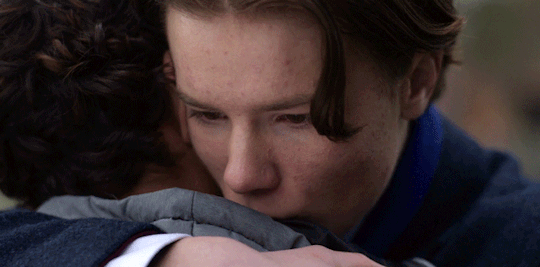
merlin only getting life updates about uther from ulfin coz he dont wanna appear in court no matter how much uther asked for him

merlin only showing up at uther's deathbed to tell him that the baby arthur is fine and that uther could finally rest

merlin still being called "uterpendragon's beloved" years after uther's death and even when arthur was king. arthur acknowledging it and then pleading with merlin as someone that his father loved very much.

merlin x uther, folks.
#merlin#uther pendragon#prose merlin#historia regum britanniae#merlin x uther#arthuriana#yeah i have taste
15 notes
·
View notes
Note
🙂
What are some (say 5 if possible) major differences with the Merlin Lore and the BBC show Merlin?
To make this easier, I’ll list Lore that is, then what the Show has then expand. And I also, perchance, may have ended with 8 rather than 5....
Now, the lore shifts depending on Author, as such, we have examples of different characters doing the same acts (Lancelot and Mordred) while some characters end up with multiple versions of names due to the myths transforming across lands and space and time (Bedivere/Bedwyr/Bédoier/Bedevere or Caradoc/Caractacus/Caradog Freichfras/Carados Briefbras or Walwanus/Gwalchmei/Balbhuaidh/ Gawain/Hauwaine/Gwaine and possibly more important to what I’m referring to Guinevere/Gwenhwyfar/Gwenivar/Gwynnever/Guenevere/Guenever/Gwen)
1. Lancelot and Gwen.
In the show we get the nice blossoming relationship that starts early on. Lancelot is all the things that Gwen comes to love in Arthur, and Lancelot is, as half the characters are, smitten with Gwen. He stands aside, in the show, letting Arthur have her [which is a bullshit interpretation, Gwen has agency, she chose Arthur but whatever]. In the Lore, however, this is more of where Shade!Lancelot shows up, as the Lancelot-Guinevere love story shows up. This is first seen in the 12th century Lancelot, The Knight of the Cart, in which the reader is introduced to adultery being committed with an already married Queen and a knight that was sent to protect her. Now, Chrétien de Troyes’ work invented this affair to counter Mordred-Guinever’s affair (as Mordred is often depicted as Arthur’s nephew in early works), after introducing Lancelot in his earlier work Erec and Enide (roughly 1170).
The Lancelot-Gwen story gets really popular in the 13th century, specifically in France, probably because Lancelot is a french addition, but anyway, this is roughly where we get Sir Thomas Malory’s adaptation which brings in Lancelot as a youthful teen who is knighted by Queen Guinevere and later rescues her from Maleagant (which is similar to The Dark Tower episode in a way) and afterwards the affair between the two eventually leads to the fall of Arthur and themselves. In Malory’s Le Morte d’Arthur Guinevere is often portrayed as, honestly, a bitch [lots of annoying jealousy, deciet, adultery]. Within the works Lancelot falls into Madness and later, once revealed as a betraer of his King (for multiple reasons), Lancelot kills several knights and escapes, but then returns to stop Guinevere’s execution at the stake and in the time of battle, Gaheris and Gareth, brothers of Gawain are killed, Gawain falls into a rage that pressures Arthur to confront Lancelot and eventually causes lancelots death at some point. A very long winded thing that is drawn out and also includes Mordred sometimes.
2. Geoffrey of Monmouth
Not really a ‘difference’, more of a nod to the British cleric from Wales who helped develop and popularise the Arthurian stories. The show has him working the library in Camelot (which is roughly anywhere from 410AD to 1066AD I’d have to imagine with the Anglo-Saxony problems occurring in post-Roman Britania) whereas the actual Geoffrey would have been roughly born 1095, dying maybe 60 years later. His depiction, interestingly, is often that of a bearded old man, not because this would be exactly how he looked, but in the era beards were a show of knowledge and wisdom (and ‘oh look at me I’m old and know things’) which has a standing tradition which goes back to ancient Greece when the beard was a symbol of masculinity and virility and being beardless was a symbol of youth and effeminacy (and possibly further back but I know ancient greek stuff so I’m sticking with my knowledge), although, in the show, he definitely looks maybe 100 but that might be just me looking at him like “wow he’s old.”
Anyway, his works were so influential that there is the idea of Pre-Geoffrey and Post-Geoffrey arthurian works (or rather Pre/Post Galfridian as that is his name in latin and classical languages are how works that clerics wrote are usually done thusly). Historia Regum Britanniae, the wonderful history of the kings of Britain from the settlement of Brutus of Troy, descended from Aeneas, to the Julius Caesar invasions and to real kings and fictional kings. Most of the work is based off other works like Historia Brittonum (attributed to Nennius), Ecclesiastical History of the English People (Bede), and De Exidio et Conquestu Britanniae by Gildas, along with oral works that would be traditionally passed down in communities. Now, it wasn’t his only work that remains prominent in the Series we know, as Prophetiae Merlini (Prophecies of Merlin) are utterances attributed to Merlin which have some popping up relevance in the show. Not much, to be sure, but we do have the White/Red dragon fight from this (with Aithusa/Kilgharrah not actually fighting however, but the symbolism is there).
3. Morgan Le Fey and Lancelot
In the show we briefly get this touched on with Shade!Lancelot doing a heckin bow of loyalty to Morgana (whom shall be referred here as Morgan) and kinda having heart eyes. However, in Prose Tristan, Lancelot is Morgan’s love interest/desire although he refuses her obsessive advances as he is in love with Guinevere. However, Morgan courts, drugs, enchants, and even goes so far as imprisoning Lancelot to keep him with her (in a parallel to Morrígan and Cú Chulainn). Now to the ‘shade’ aspect, there is a nice parallel to Queste del Saint Graal in which, within a vision Lancelot (and the audience) see a vision of Hell with Morgan controlling demons in the afterlife, which is similar, but also wildly different than the necromancy Show!Morgana has done to Shade!Lancelot.
4. The Isle of the Blests
This is the best parallel and difference watchers of the shows can see I’d imagine. Of course, in the show we have the Isle of the Blessed where members of the Old Religion would have gone to worship, the Isle was inhabited by high priestesses of the triple goddess and their Blood Guards and held at one point, most of the artifacts that Arthur and Merlin stumble across (Rowan Staff, Horn of Cathbhadh, Cup of Life which would be better known as the Holy Grail).
In our wonderful vast accounts of Arthurian lore, however, the Isle of the blest, or perhaps the Fortunate isles, is synonymous with the Isle of Apples, or as we more commonly know it, Avalon. Of course, in the show, Avalon was the land of the otherworld, of the sidhe, but in the lore, the isle of Avalon was where women live who know all the world’s magic. Rather, this was also where Morgan lived with her nine sisters. From Geoffrey’s Vita Merlini, we see Morgan connected with Avalon, specifically in the role of a healer to Arthur after having been injured at the Battle of Camlann, and Morgan, as the leader of the nine magical sisters (unrelated to Arthur at this point), heals him after Taliesin delivers him there [Really it’s not until the late 12th century when morgan is transformed into the supernatural elder sister of Arthur].
This account, however, of nine sisters (supposedly named Moronoe, Mazoe, Gluten, Glitonea, Gluten, Tyrone, Thiten, and Thiton) is very similar to the nine Gaulish priestesses or druidesses of Île de Sein, in which the Roman Chronicaler Pomponius Mela noted that the maidens venerated a god of prophecy and were known for their powers of 'sight' and as healers, along with having the ability to shapeshift into animals and raise storms at sea. On the note of sisters, however, it should be noted that Morgan, or rather Morgana, gains multiple different sisters from Morgause and Elaine of Garlot, along with the interesting history that surrounds Gwyar (as either a replacement for Morgause or Anna, a mother of Gawain/Gwalchmei ap Gwyar, and supposedly daughter of Amlawdd Wledig.)
5.Sir Ector Vs King Uther
In many of the lore surrounding Arthurian legends, Arthur is raised by Sir Ector as a brother of Sir Kay after joining the house as a baby to keep him safe from assassins (which Disney’s Sword in the Stone kinda gets at). Often times, when Arthur finally ascends to the throne, Sir Kay rises very quickly in prominence at court (although it’s said Kay has magic of indurance in that “nine nights and nine days his breath lasted under water without sleep” and “when it pleased him he would be as tall as the tallest tree in the forest [...] because of the greatness of his heat, and when his companionswere coldest, he would be as fuel for them to light a fire”). Although, he’s not the best knight around, nor a good role model in his actions. Nevertheless, Sir Ector is, in the works of Robert De Boron and Thomas Malory, given Arthur by Merlin who, with permission (usually or believed) by Uther and Igraine, brought Arthur to safety. Merlin doesn’t reveal the identity of the boy to Ector, and Ector raises him as a son, next to his own. This differs of course from the Princely raised Show!Arthur the audience watches. Not the biggest difference about, for Sir Ector is actually not that big of a ‘player’ in the scheme of their universe, but it is interesting to note nonetheless.
6. Minor Characters: Tristan and Isolde / Elaine of Astolat
Tristan and Iseult/Isolde have an entire prose cycle (Prose Tristan) based around them, and this was limited to a few scenes in the show. Understandable, as we are focusing on Arthurian progression from Prince to King, but the characters are based off the Cornish Knight Tristan falling in love with the Irish Princess Iseult (daughter of another Iseult, cause we love repetitive names in families. Definitely keeps family lines clear to see). Now, some versions have them ingesting a love potion, others have it as true love between them. Nevertheless, Tristan isn’t supposed to be in love with her because he’s delivering her to Cornwal to marry his uncle, King Mark. In one version the potion was supposed to be ingested by Iseult and King Mark to make a love-match between the two, but things got fucked up. Anyway, most times Iseult does marry King Mark and then we got adultery on the side which then the king’s advisors catch onto and try to convict them of. And this does madness stuff and what-not and at some-point you have a Hepheastus moment where King Mark is trying to trap Ares and Aphrodite, sorry, I mean Tristan and Iseult for proof. Tristan is to be hung and Iseult is to be burnt at the stake (or sent to a leper colony or both), anyway, Tristan escapes, rescues Iseult, and now they’re in the woods as outlaws. Which, in the lore they sometime return to have Iseult marry Mark properly as Tristan fucks off to adventure somewhere and Iseult has a happyish marriage until Mark dies and Tristan returns. Anyway -- Kinda similar to what we see, we just have them at the outlaw part of existence when Tristan is cursing the name of his Kingly Uncle and swearing off nobility.
Elaine of Astolat/Ascolat supposedly is a figure who dies from unrequented love of Lancelot - bear with me - and drifts down the river to Camelot in a boat in the Mort Artu 13th century French romance - bear with me - while clutching a lily in one hand and a letter in the other. Elaine is found by King Arthur’s court, the letter is read, Lancelot feels ashamed and pays for a burial. The reason I mention this is it’s a similar death scene to many of the imporant characters we see die in BBC Merlin, and in particular, Lancelot and Freya. One, very important to Merlin, not quite an unrequited love, but near enough. The Other, the very man who broke Elaine’s heart in the prose.
7. Princess Gwenhwyfar
I’m using this name as a nod to The Dragon’s Call, in which when Gwen introduces herself to Merlin in the stocks, that is what the subtitles say. The lore surrounding Gwen is wild. She is a villainour opportunistic traitor. She is a loving wife. She is ‘if she were a spice she’d be flour’. And she is a fatally flawed but noble and virtuous lady. Too many versions. Each author changes her character the most as compared to literally all others. The biggest shift from Merlin’s show to the lore, however, is Gwen is never a servant/maid, and she is Elyan the White’s sibling. The main thing here, I’d say, is her father King Leodegrance (in some versions) and sister Gwenhwyfach (false Guinevere). Different traditions have her with different family (Cywryd of Gwent / Gwythyr ap Griedawl / Gogrfan Gawr (specifically Gwenhwyfar ferch Ogrfan Gawar Drwg yn fechan, gwaeth yn fawr or ‘Gwenhwyfar, daughter of (G)Ogrfan Gawr, bad when little, worse when great ) / Garlin of Gore / King Madaglan (although he is an uncle I think?)) Lots of fathers nevertheless. Too many. Head hurts trying to look at genealogy for Gwen. Now, in addition to this, as mentioned above, Elyan the White (Helyan le blanc/Elain/Elayn/Helain/Hellaine/Helin - the pale / le blank) is the son of the Knight Bors the younger, and his mother Claire, daughter of King Brandegore. Anyway, with Elyan, he doesn’t interact much with Gwen until having to help his cousin Lancelot rescue her after the affair is exposed, then also joins Lancelot in exile, and later, (following the vulgate cycle) he becomes Emperor of Constantinople.
8. Excalibur/Caliburn
Arguablly these are the same sword with different names. However, typically, Caliburn is the Sword that is stuck in the stone while Excalibur is given by the Lady of the Lake after Caliburn breaks in a fight. Although, then again, naming issues. Caliburn is the latin from the Breton Kaledvoulc’h, Welsh Caledfwlch, and Cornish Calesvol. The name Excalibur derives from the Caledfwlch, however the two are still depicted as different swords most often. Generally, the sword in the stone is the whole divine right of kings bullshit that keeps monarchy in power for most of history. Sometimes when Caliburn breaks in a fight, Merlin takes the same sword to the Lady of the Lake to make it whole again, reforged into Excalibur (nearly seen in the name ex-calibur(n) - out of caliburn). From what we watched back in… 2009-2013+ Excalibur is forged by Tom, Gwen’s father, breathed magical by Kilgharrah, given by Merlin (accidentaly to Uther), tossed into the Lake, returned by Freya (thus given by the Lady), then struck into Stone to give Arthur belief that he had god’s will on his side because of old prophecies that Merlin definitely made up but made everyone believe.
#bbc merlin#merlin#Vita Merlini#geoffrey of monmouth#Bede#history#comparison#analysis#Prophetiae Merlini#Historia Regum Britanniae
10 notes
·
View notes
Text
I really enjoy how often Geoffrey of Monmouth will say things like “What more can I say” or “I could keep going but it would take too long” or “I could describe this to you but another guy did it better”
I wish I could do that when I write essays
#I’m paraphrasing of course#also I love that the guy he said did a better job of telling the story definitely did not do that#like he did not tell that story ever#Geoffrey what were you DOING#did you just assume it would be to hard for anyone to fact check?#clearly Geoffrey did whatever he wanted#which was so valid of him#geoffrey of monmouth#a history of the kings of Britain#historia regum britanniae#florilegia
2 notes
·
View notes
Text
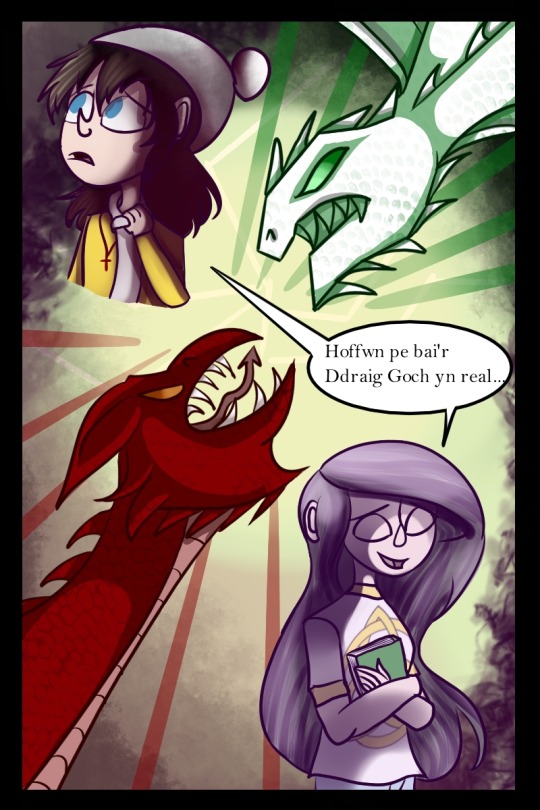
“Woe to the red dragon, for his banishment hasteneth on. His lurking
holes shall be seized by the white dragon, which signifies the Saxons
whom you invited over; but the red denotes the British nation, which
shall be oppressed by the white. Therefore shall its mountains be levelled as the valleys, and the rivers of the valleys shall run with blood. The exercise of religion shall be destroyed, and churches be laid open to ruin." -- Historia Regum Britanniae, Geoffrey of Monmouth, Chapter 3, Page 13, https://www.yorku.ca/inpar/geoffrey_thompson.pdf.
#the vale of wales#vow#welsh mythology#welsh folklore#wales#amanda#y ddraig goch#Gwyvern#White Dragon#Red Dragon#Chapter 14#Page 34#historia regum britanniae#geoffrey of monmouth
0 notes
Text
arthurian legend is such a rabbit hole holy shit, I have 12 books on hold at the library and I’m not even done going down my list 😵
thank you so much @cutoutdalek again for your recommendations!! good thing most of them are poems 😭
#I refuse to read through the original le morte d’arthur jesus christ it’s so long gimme the children’s books pls alsdfkjlkasdjf#I’m skimming Historia Regum Britanniae just to say I’ve read it but it doesn’t seem like it’ll be too narratively helpful#then I keep getting sucked into celtic and welsh influences#the poems and later adaptions are really gorgeous tho#and I need to keep cross referencing for antisemitism I might come across and need to avoid#ALL THIS FOR FUCKING HIJACK#HOW DID I GET HERE#*RATTLES CAGE* LEMME OUTTTTTTT
68 notes
·
View notes
Text
has the arthurian fanbase here gotten wind of sistersong by lucy holland yet
#arthuriana#ballads#i personally really enjoyed it i liked a lot of the post roman britian/de excidio/historia regum britanniae references/allusions#it is definitely fantastical..but it's not fantasy. like definitely in the arthurian chronicle tradition of some batshit insane#magical things happening in the midst of..real history#i liked the way the original child ballad was woven into the plot but i wasn't expecting how it came in..exactly#keyne was definitely a real treat i wasn't expecting and that's a big reason why i think the book would be a tumblr hit
0 notes
Text
honestly the choice to make geoffrey of monmouth a character in merlin is one of the funniest things the writers could have done. we know the myth survives and that arthur's story 'will live long in the minds of men', so we can assume that the major arthurian works were still written, including historia regum britanniae and prophetiae merlini, both of which were written by geoffrey. knowing this, we have two possible avenues of interpretation open to us: 1) that geoffrey had no idea what was going on, which seems fairly unlikely. and 2) that he knew full well that what he was writing was pure bullshit and gave precisely zero fucks about it, and i for one think that is hilarious.
650 notes
·
View notes
Note
Hello, I saw your answer (and therefore explanation) of Gawain and his many lovers and wondered if you also had some insights into the relationship between Kay and Bedivere? Was that a solely adventure buddies kinda thing or a little bit more perhaps? Anyways I hope you have a lovely evening
hey there!
oh yay i love them! i incorporated a lot of bedivere into my kay webweaving post and in my book series i modeled their relationship after real life knights sir john clanvowe and sir william neville. let's get into it! :^)
for starters, kay and bedivere are two of the oldest arthurian characters, so their "history" is long. which is very fun! in the mabinogion, kai and bedwyr refer to each other as "companions." the word is sometimes applied to all members of arthur's fellowship (ie "companion" of the round table) but i really enjoy the idea that it can speak to a deeper connection than "coworker." let's look at a couple passages.
in culhwch and olwen, kai and bedwyr are sent by arthur on a quest. their introductions are back to back with a list of their fun magical powers. notably, bedwyr's opens like this.

they are the definition of "comes as a set, do not separate." their apparent inseparability becomes a theme from here. later, kai works some blacksmithing, prompting this exchange.
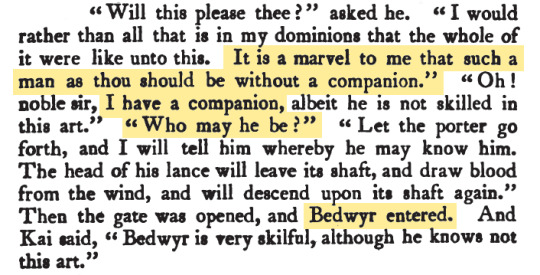
literally what is this supposed to mean? if "companion" refers to all of arthur's men, then explain this...wild. off to a strong start. then comes the rescue of mabon, where kai and bedwyr ride together on the back of a huge salmon.
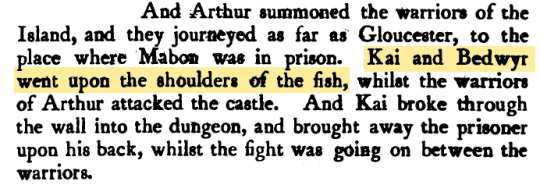
and here's some kickass artwork of this adventure by margaret jones, which i scanned for all to read!

but wait, there's more. last note about the mabinogion is that kai has his own turn of phrase referring to bedwyr's missing hand, which can seem a bit mean-spirited, but is received as more of an inside joke.

crazy stuff. okay. brace yourself for our boy geoffrey of monmouth's the history of the king's of britain. here kay and bedivere gain roles that go hand in hand, seneschal and cupbearer ("server" and "butler" in this translation). when arthur has to fight and kill the giant of mon saint michael, he chooses only two people to bring with him. guess who.

later, during the war, they are assigned to co-command one of the factions.

and then.....the ending. bedivere is slain, and kay sacrifices himself in the effort to retrieve his body.

sick and twisted narrative choices, geoff. i'm looking away.
to answer your question, yeah, i think together they make the most wonderfully annoying middle management married couple in camelot and menace all their employees in an ever-revolving door of "go ask my husband" that drives everyone mad. arthur finds it highkey hilarious<3
thanks for asking!
#arthurian legend#arthurian legends#arthuriana#arhturian mythology#kay#sir kay#bedivere#sir bedivere#bedwyr#sir bedwyr#quotes#the mabinogion#mabinogion#the history of the kings of britain#historia regum britanniae#geoffrey of monmouth#ask#anonymous#my post
16 notes
·
View notes
Text
When reading the Arthurian stories, do you just replace any mention of the Pope and the Archbishop of Canterbury with St. Dubricius?
Like the obvious anachronism is that the first archbishop of canterbury is St. Augustine, and he wouldn't come until long after Camlann.
#arthuriana#arthurian legend#arthurian mythology#arthurian legends#king arthur#queen guinevere#dubricius#historia regum britanniae#catholic pope#archbishop of canterbury
6 notes
·
View notes
Text
History of the Kings of Britain, continued...
2. Of the first inhabitants of Britain.
Britain is the most excellent of islands, situated in the Western Sea between France and Ireland. It is eight hundred miles in length, two hundred in width. Whatever suits the use of mortals, it provides in boundless plenty; for it is rich in every kind of metal, and boasts wide open fields and fine hills for farming, in which a variety of fruits arise richly from the soil in their seasons. It has woodlands filled with every kind of wild beast, and in the glades and other feeding-places of the woods these find grasses, while flowers of many colours disburse their honey to the hovering bees. It contains flourishing meadows, too, in lovely spots beneath the airy mountains, where clearest springs feed into bright streams with a gentle sound, inciting sweet sleep in those who lie upon their banks. It is further watered by lakes and rivers full of fish. Along the strait of the southern region (whereby one may sail to France), three noble rivers reach like three arms: these are of course the Severn, the Thames and (not least!) the Humber. Up them goods are brought across the sea from every nation, by passage of said strait.
The island was once adorned with eight and twenty cities. Of these, some are now crumbling into ruins and deserted; others, intact, still contain shrines to the saints, their towers upright in lasting beauty. Devout congregations of men and women there offer praise to God, according to the Christian tradition.
Finally, this island is inhabited by five peoples: the Normans* of course, as well as the Britons, the Saxons, the Picts, and the Scots. The earliest among these were the Britons, who once occupied the island from sea to sea until, thanks to their hubris, divine wrath descended on them and they fell to the Picts and the Saxons. That will suffice as a summary of how these things came about; it will be explained more fully in the following chapters.
*Lewis Thorpe says "Norman-French" here, which makes sense historically. My source says Romani, but I'm suspicious it may be a typo from Normanni.
#my translation#latin#medieval literature#galfridus monumotensis#geoffrey of monmouth#historia regum britanniae#history of the kings of britain#arthuriana#amateur latinist
11 notes
·
View notes
Text
I did it! I read the *entirety* of Historia regum Britanniae by Geoffrey of Monmouth.
Would I recommend reading the whole thing? I'm not really sure. I think the original founding of Britain by the Trojans is kind of interesting to read about. Then it gets markedly less interesting for a while, with some gems such as a necromancer king and his school of necromancy, and a number of very powerful queens which I also didn't expect from a medieval Chrisian author (but he may have been writing in support of Matilda as heir to the throne during Geoffrey's time). Eventually the Arthurian section begins, and that's a reasonably engaging read. Certainly all the lead-up provides *context* for Arthur's reign.
Michael Faletra's translation was highly readable and I'd recommend it, though it can be a little hard to find. (The only ebook version I found still actually available was on Google Play books. Couldn't find it on Kindle or iBooks.) I found Faletra's introduction and translator's notes as interesting (or more so) as the book itself, and his copious footnotes are very helpful at providing further context.
The biggest bonus to Faletra's translation, though? The appendices! He has a translation of the Vita Merlini (Life of Merlin) by Geoffrey of Monmouth, as well as translations of relevant excerpts from Welsh poems, pre-Galfridian texts, medieval reactions to Geoffrey's History, and so on.
If you're just interested in the Arthurian-specific bits, Geoffrey of Monmouth dedicates about 1/5th of the text to Arthur. I'd start with Book 6 (they're called Books but they're more like chapters, very short); Arthur's father Uther shows up a few pages into it. You'll get the introduction to Merlin, the whole reign of Vortigern, and the influx of Saxons across the kingdom which sets up for one of the big achievements of Arthur's reign.
Book 7 is very Merlin focused, and covers his prophecies. They're obscure, as prophecies often are. Faletra's footnotes contextualize the ones that reference events prior to Geoffrey's time, which is handy.
Book 8 covers Uther, Gorlois, Igerna (Igraine in later texts), and Arthur's conception and birth along with his sister Anna (later called Morgana, I'm guessing). All of Uther's reign. The reign of Uther's brother Aurelius comes first though.
Book 9 is the really Arthur-focused book. We get his kingship, the shield Pridwen, the "greatest of swords" Caliburn (later Excalibur), and mentions of Avalon. We're also introduced to Gawain and Mordred, sons of Loth, who was married to Arthur's sister Anna. Arthur marries Guinevere, born of a Roman family and raised in the household of the Duke of Cornwall. And then Arthur works on conquering practically the entirety of Northern Europe, and his court becomes a popular destination for glory-seeking young men wanting to be knights. We additionally meet Bedivere the Cup-Bearer and Kay the Seneschal, and travel to Caerleon.
Book 10 is a conflict with Rome (with whom Britain has had a long and complicated history before this point in the Historia). Arthur leaves Britain to Guinevere and Mordred's care and goes to Rome. On the way he randomly fights and kills a giant in single combat, like you do. In the war against Rome, Bedivere is slain and Kay receives a mortal wound. And at the very end, they learn that Mordred has seized the throne for himself and is hooking up with Guinevere. (To quote: "news reached Arthur that his nephew Mordred, in whose keeping he had left the governance of Britain, had proven himself to be a tyrant and a traitor. Mordred had seized the throne of Britain and now took his wicked pleasure with Guinevere, who had broken her marriage vows.")
Book 11 is the Battle of Camlann. Ywain is first mentioned here (later called Yvain in works by Chretien de Troyes). Mordred is killed at Camlann, and Arthur is mortally wounded but carried away to Avalon to be healed. The next king is crowned, Constantine, who kills Mordred's two sons in the churches they were hiding in. The rest of Book 11 is a rapid series of following kings and conflicts.
Book 12 has a final drawn-out conflict between kinsfolk over the throne, and wraps up the end of the History; it really isn't necessary to read book 12 if you're just here for Arthurian content. I found it an absolute slog and struggled to keep my eyes from skipping over paragraphs.
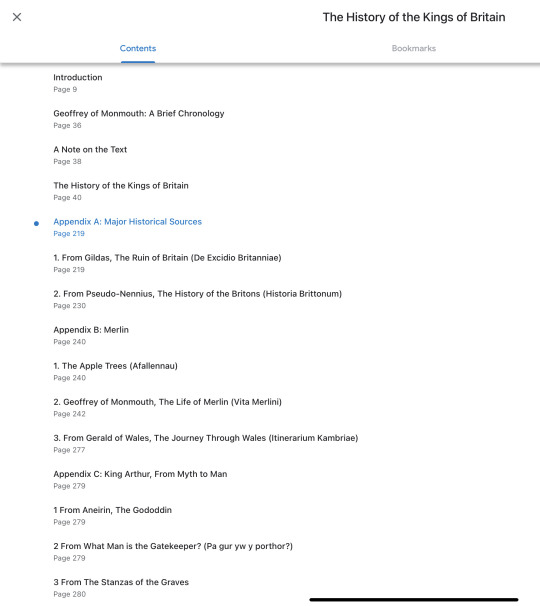

#arthuriana#arthurian literature#arthurian newbie#geoffrey of monmouth#reading list#historia regum britanniae#history of the kings of britain#michael faletra
8 notes
·
View notes
Note
Wait, if Mordred married Guinevere in the earliest Arthuriana, wouldn't that mean Mordred is some sort of proto-Lancelot?
Now that you say it. It makes sense!
Accdg to Overly Sarcastic Productions Youtube, pre-Arthuriana Briton records (around 900 AD) say that there was an Arthur and a Mordred that fought in a battle somewhere. There are no records on why they fought, where they were from, who won or if they died. If that was the battle that Monmouth based his pseudohistory from, it makes sense that everybody else would expand his lore like that.
4 notes
·
View notes